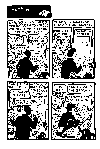
Drop-in
Dave Lapp
conundrum press
$17
paper
160pp
978-1-894994-33-0
Lapp’s presentation is simple and inviting. So much is said in the quieter frames, such as in the weak, apologetic smile of a youth after opening up about a suicidal parent. Lapp slips into poignant comments so quietly it’s easy to miss them. After hunting out and dissecting the homes of bugs in a grassy field, Dave says, “I’m glad we’re leaving without destroying any more homes.” Yet we know that most of the children he is with come from broken homes and struggling families.
Drop-In captures the random, bewildering behaviour of children. The protagonist often stands bemused at the children around him, whether they are dashing through the margins of the frames, hovering around him affectionately, or lashing out at the other children.
Dave is often left in the dark, confused and befuddled. He is an outsider, and Lapp lets his portrait of this position play out. He often refuses resolution, leaving conflicts, questions, and even narratives dangling. But these fragmented stories speak for themselves. The jumble of incomplete snapshots feels apt in the context of a drop-in centre – a place with an unstable attendance of attention-deficit-disordered and attention-deprived children. This gives Drop-In its true-to-life quality. The stories pop in and out of Lapp’s narrative in much the same way that the children pop in and out of Dave’s life. He is doing his best to connect with them, but he knows his place and is frustrated at the futility of it all.
But patience is one of Dave’s virtues. A particularly confused note from one of the children states: “You or go to me.” He remains puzzled until the child deciphers her writing: “You are good to me,” she says.
Moments of joy tangle with moments of fear, and aggression with ambivalence. Dave points to a racist slur left long ago on a doorway at the drop-in centre and asks why nobody erases it. “Because nobody cares” is the reply. In these pages, Lapp seems to care, and as a result, so do we. mRb






0 Comments